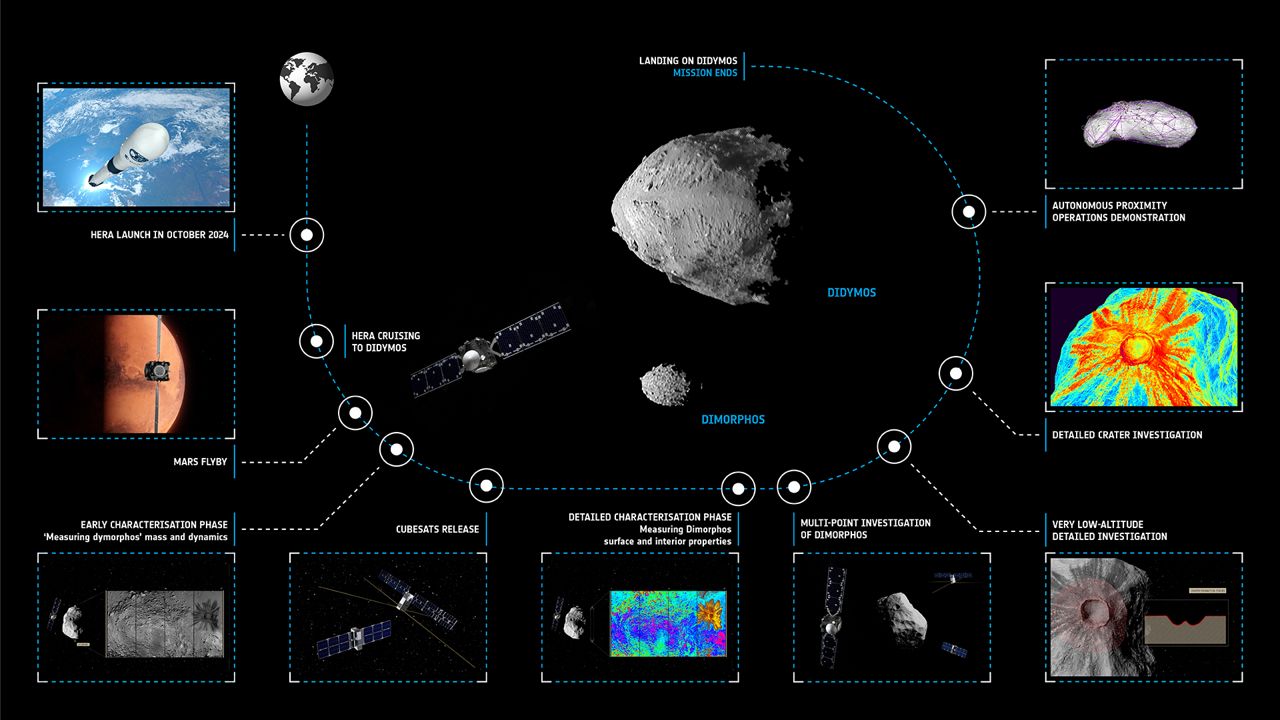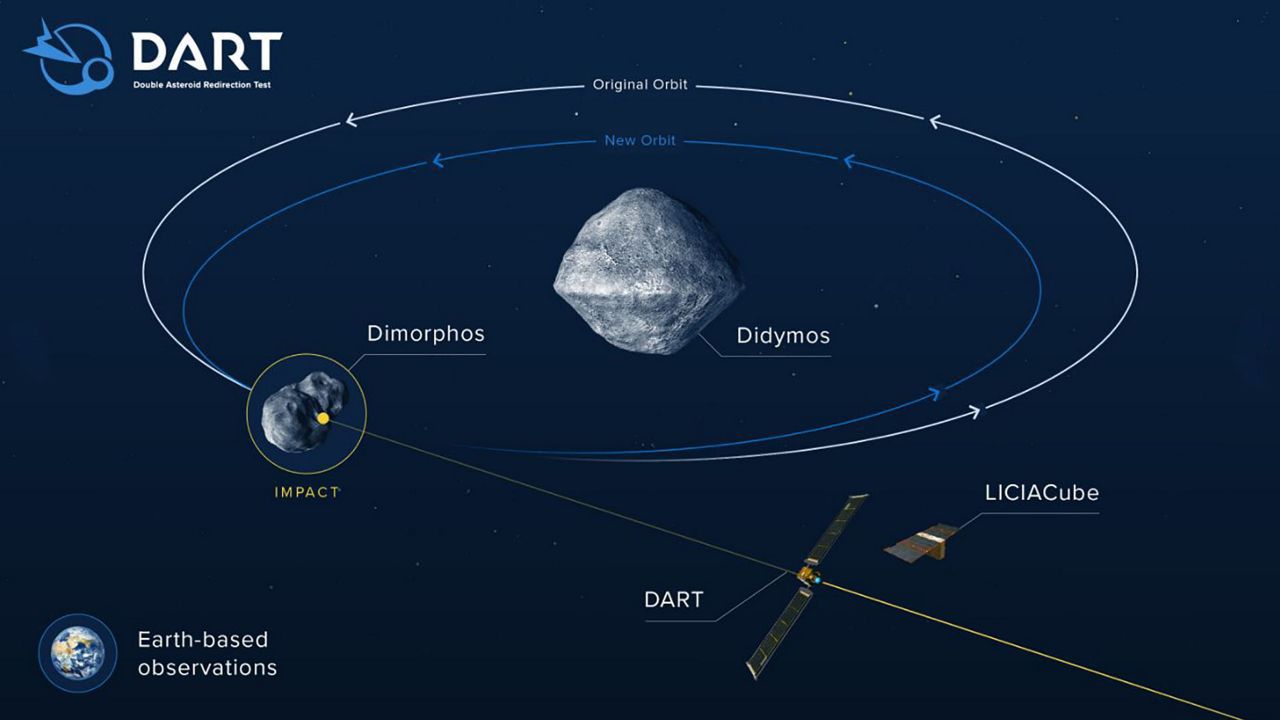CAPE CANAVERAL SPACE FORCE STATION — SpaceX has launched the European Space Agency’s Hera asteroid mission on Monday morning, which will follow up on a NASA mission two years ago when it intentionally rammed the DART spacecraft into Dimorphos.
What You Need To Know
- Weather did not look promising
- The Hera mission will determine how much change there has been to Dimorphos’ orbit around its bigger sibling Didymos
- The DART mission was a planetary test to see if humans can change an asteroid’s path
- RELATED coverage: NASA successfully crashes DART spacecraft into asteroid
- Get more space coverage here ▶
- 🔻Scroll down to watch the launch🔻
Liftoff of @ESA’s Hera! pic.twitter.com/mMoNPzX0b6
— SpaceX (@SpaceX) October 7, 2024
SpaceX’s Falcon 9 rocket took off from Space Launch Complex 40 at Cape Canaveral Space Force Station on Monday at 10:52 a.m. ET, stated the Kennedy Space Center and reported SpaceX.
The 45th Weather Squadron gave a 15% chance of good launch conditions, with the main concerns being the thick cloud layers and cumulus cloud rules. However, later on Monday morning, weather officials increased the chances to 50%.
Find out more about the weather criteria for a Falcon 9 launch.
SpaceX stated that if the launch was scrubbed on Monday, the next attempt would have been the following day at 10:46 a.m. ET.
This is the 23rd mission for this Falcon 9’s first-stage booster, called B1061. It has launched two crewed missions, Crew-1 and Crew-2, but most launches for this workhorse have been supply runs to the International Space Station and satellites for different space companies and global government operations.
Most of its later launches have been done from California.
And this will be old B1061’s last mission as it will not be landing on a droneship or landing zone. SpaceX stated it would not be recovery the booster on Monday.
“Due to the additional performance required to deliver the payload to an interplanetary transfer orbit, this mission marks the 23rd and final launch for this Falcon 9 first stage booster …,” SpaceX commented.

About the mission
The DART mission was a planetary defense test to see if a human-made spacecraft could re-direct an asteroid’s path.
And it was successful as the DART spacecraft went to the binary asteroid system that is home to Didymos, about half a mile (0.8 kilometer) in diameter, and the small moon (sometimes called a moonlet) Dimorphos, which has a diameter of 525 feet (160 meters) and was the target of the experiment.
On Monday, Sept. 26, 2022, the DART spacecraft was used as a missile as it was speeding at about 4 miles per second as it smashed into Dimorphos. The little asteroid was no threat to Earth, but it was used to determine if a human-made spacecraft could change the orbit of a space rock if it were heading towards the planet.

Dr. Andy Rivkin, the DART investigation team co-lead at the Johns Hopkins Applied Physics Laboratory, explained to Spectrum News that prior to the test, Dimorphos took less than 12 hours to orbit Didymos and that his team expected the new orbital time to be a change of 10 minutes after DART crashed into the little moonlet.
However, NASA stated later than the experiment was a much bigger success than anticipated, with a 32-minute orbital difference.
Now the European Space Agency will send up the Hera spacecraft (and two CubeSat passengers) on a follow-up mission to determine the effects of the DART mission.
“… Hera will assess the effectiveness of asteroid deflection and help turn this experiment into a well-understood and repeatable technique for planetary (defense),” the European Space Agency stated.

Understanding Hera and its two traveling companions
Hera is about the size of a small car, about 5 feet (1.6 meters) across per side and when its solar arrays are fully deployed, they will each stretch out about 38 feet (11.5 meters) and should arrive at its target sometime in 2026.
This little spacecraft is jam-packed with equipment: Different cameras and a thermal infrared imager will be used to take photos and make various measurements. Plus, it also has two star trackers to help with space navigation.
Many of the equipment onboard Hera comes from private European companies and Japan’s space agency, JAXA.
Hera’s traveling companions are Milani and Juventas and they are both about the size of a shoebox.
These CubeSats, nanosatellites, have their own important missions. Milani will take spectral measurements of the surfaces of the two asteroids.
Milani will be “measuring the sunlight they reflect and breaking down their various colours to discover how these asteroids have interacted with the space environment” and it “will sample the dust surrounding these bodies, to detect volatiles such as water, characterise light organics and to monitor any molecular contamination of the CubeSat,” explained the European Space Agency.
And Juventas will have a special part of its mission after it is done performing the first radar sounding of an asteroid’s interior. It will scan about 328 feet (100 meters) deep of Dimorphos’ 525-foot (160 meter) diameter being.
Then Juventas will line up with Hera and perform a series of radio-science experiments while conducting a low-frequency radar survey and an X-ray-like scan of Dimorphos.
But that is not all for the little satellite.
“The adventure will end with a landing, using the dynamics of any likely bouncing to capture details of the asteroid’s surface material – followed by several days of surface operations,” explained the European Space Agency.



